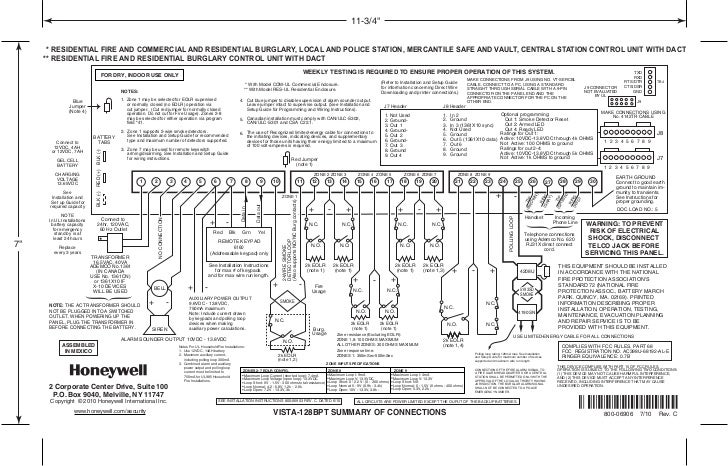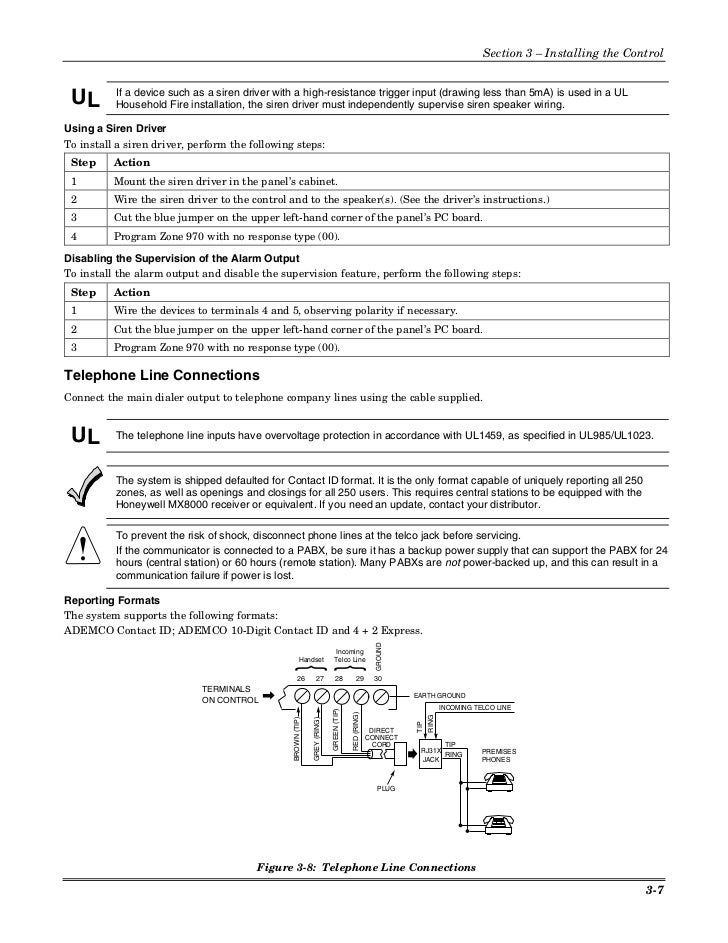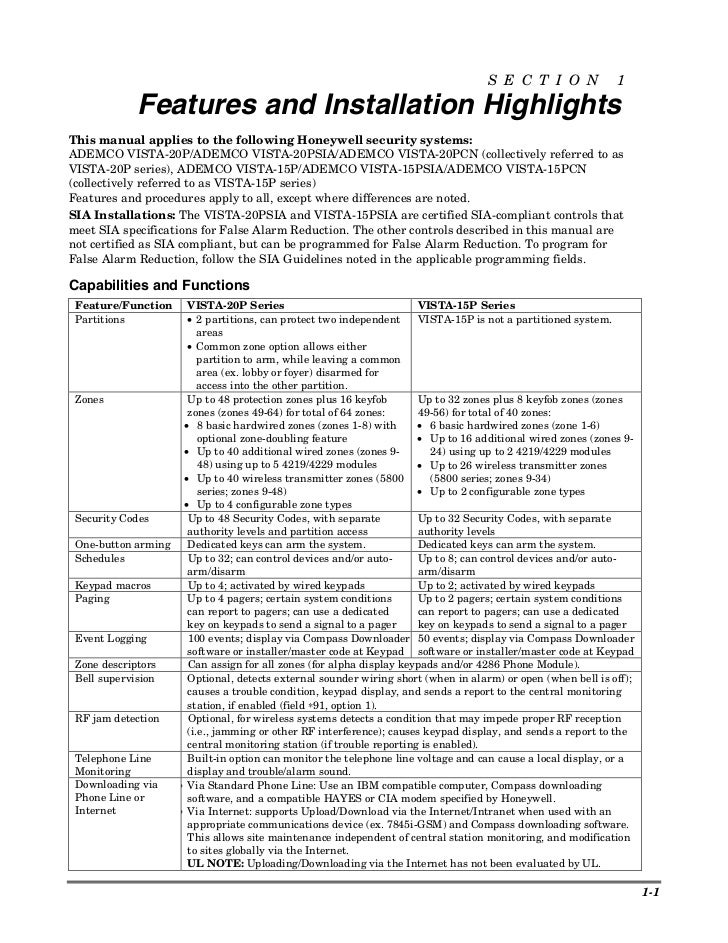Honeywell Vista 20p Installation Manual Pdf
IMPORTANT!PROPER INTRUSION PROTECTIONFor proper intrusion coverage, sensors should be located at every possible point of entry to a home or commercial premises. This would include any skylights that may be present, and the upper windows in a multi-levelbuilding.In addition, we recommend that radio backup be used in a security system so that alarm signals can still be sent to the Central Monitoring Station in the event that the telephone lines are out of order (alarm signals are normally sent over the phone lines).EARLY WARNING FIRE DETECTIONEarly warning fire detection is important in a home. Smoke and heat detectors have played a key role in reducing fire deaths in the United States. With regard to the number and placement of smoke/heat detectors, we subscribe to the recommendations contained in the National Fire Protection Association's National Fire Alarm Code (NFPA 72). These recommendations can be found on page 47 of this manual.SYSTEM COMPATIBILITY NOTICEYour Honeywell security system is designed for use with devices manufactured or approved by Honeywell for use with your security system.
Your Honeywell security system is not designed for use with any device that may be attached to your security system's keypad or other communicating bus if Honeywell has not approved such device for use with your security system. Use of any such unauthorized device may cause damage or compromise the performance of your security system and affect the validity of your Honeywell limited warranty.
When you purchase devices that have been manufactured or approved by Honeywell, you acquire the assurance that these devices have been thoroughly tested to ensure optimum performance when used with your Honeywell security system.About This ManualThis manual is a step-by-stepguide that will acquaint you with the system's features and benefits. It defines the components and their functions, describes their operation, and provides clear step-by-stepinstructions for normal and emergency procedures. Keep this manual in a convenient place so that you can refer to it as necessary.– 2 –. System OverviewIntroductionCongratulations on your ownership of a Honeywell Security System. You've made a wise decision in choosing it, for it represents the latest in security protection technology today. This system provides:. Three forms of protection: burglary, fire.
and emergency. At least one keypad which provides control of system and displays system status. Various sensors for perimeter and interior burglary protection. Smoke or combustion detectors. designed to provide early warning in case of fire.
Your system may also have been programmed to automatically send alarm or status messages over the phone lines to a Central Monitoring Station. Commercial installations and some residential systems may not include fire protection – check with your installer.NOTE: Features and procedures described in this manual apply to the VISTA-20P/VISTA-20PSIA (VISTA-20Pseries) and VISTA-15P/VISTA-15PSIA (VISTA-15Pseries) security systems. Differences are noted where applicable.System BasicsBurglary Protection. Several modes of burglary protection: Stay, Night-Stay,Away, Instant, Maximum. Message Center FunctionsToPress these keysNotesrecord aThe red MESSAGE LED lights.#01OFFmessageMessage remains in memory until aFUNCTIONVOICERECORDnew message is recorded.endThe red MESSAGE LED flashes,1 OFFrecordingindicating message waiting.RECORDplay aThe recorded message plays and the#03STAYmessagered MESSAGE LED turns off.FUNCTIONVOICEPLAYadjust theAdjusting message volume also#02AWAYvolume, then pressadjusts status volume.
VolumeFUNCTIONVOICEVOLUMEcannot be adjusted while playing.volume key 3 ↑ (up) or 6 ↓ (down). About The KeypadsGeneral InformationYour keypads allow you to control all system functions and feature the following:. A telephone style (digital) keypad. Liquid Crystal Displays (LCD) that show the nature and location of all occurrences. Built-insounder that sounds during alarms and troubles. The sounder also 'beeps' during certain system functions and also when depressing any of the keys (to acknowledge the key press). Backlighting of the LCD display windows.
Backlighting turns on when any key is pressed or when entering the premises through any assigned entry/exit door. This feature is helpful when a keypad is located in a dimly lit area.
Some keypads have a voice feature that announces the nature and location of all system occurrences. Voice keypads also announce any faulted entry/exit or perimeter zone when Chime mode is on. Ask your installer if this option has been programmed for your system.IMPORTANT: If the keypad beeps rapidly upon entering the premises, it indicates that an alarm has occurred during your absence and an intruder may still be on the premises. LEAVE IMMEDIATELY and CONTACT THE POLICE from a nearby safe location.Your keypads are functionally the same, but may have different types of displays, depending on the type installed with your system.Alpha Display2-linealpha display keypads feature a 2-line, 32-characteralphanumeric LCD that displays system messages in friendlyEnglish. BYPASS: This appears when one or more burglary protection zones have been bypassed.NOT READY: Appears when burglary portion of the system is not ready for arming (due to open protection zones). The system is ready to arm when this message disappears and the READY indicator light comes on.NO AC: Appears when AC power has been cut off. System is operating on backup battery power.AC: Appears when AC power is present.CHIME: Appears when the chime feature is activated.BAT: Low battery condition in a wireless sensor (if zone number displayed) or low system battery (if no zone number displayed).ALARM: Appears when an intrusion has been detected and the system is armed (also appears during a fire alarm or audible emergency alarm).
Accompanied by the protection zone in alarm.CHECK: Appears when a malfunction is discovered in the system at any time, or if an open is detected in a fire zone at any time, or a fault in a DAY/NIGHT burglary zone during a disarmed period. Accompanied by a display of zone number in trouble.FIRE: Appears when a fire alarm is generated. Accompanied by a display of the zone in alarm.A FIRE display also appears when a fire alarm is manually activated, accompanied by a display of the fire emergency key zone number.CANCELED: Appears when an alarm has been silenced by the Code + OFF sequence and will remain on until another Code + OFF sequence is keyed.
IMPORTANT!. Match the numerical callouts in the above graphic with the corresponding number on the following pages for a description of usage. When entering codes and commands, sequential key depressions must be made within 4-5seconds of one another. If 4-5seconds elapse without a key depression, the entry will be aborted and must be repeated from its beginning.
Be sure to observe this precaution when performing any of the procedures in this manual. If you make a mistake while entering a security code, stop, press the key, and then start over.
If you stop in the middle while entering a code, and then immediately start the entry over, an erroneous code might be entered.– 11 –. NOTE: The functions printed directly on the keys indicate their primary purpose; the functions printed under some of the keys (shown in brackets under the respective key), indicate their alternate or secondary purpose.1. DISPLAY WINDOWAlpha Display Keypads: 2-line, 32character Liquid Crystal Display (LCD) keypads that display protection point identification, system status, and messages.Fixed-WordDisplay Keypads:Display protection zone ID and system status messages using pre-designatedwords in the LCD display area.2. 1 OFF Disarms burglary portion ofthe system, silences alarms and audible trouble indicators, and clears visual display after problem's correction.RECORD On Voice keypads, used in conjunction with the FUNCTION and VOICE keys to record up to a 2.5- minute message.3. 2 AWAY Arms the entire burglarysystem, perimeter and interior. VOLUME On Voice keypads, used in conjunction with the FUNCTION and desired volume control keys ↑ 3 or ↓ 6 to adjust the volume of a recorded message or voice system status.4. 3 STAY Arms perimeter portion ofburglary system only.
Interior protection is not armed, allowing movement within premises without causing an alarm. If pressed twice in succession, arms system in Night-Staymode.
PLAY On Voice keypads, used in conjunction with the FUNCTION and VOICE keys to play the recorded message. ↑ On Voice keypads, used in conjunction with the FUNCTION and VOLUME keys to raise the message and voice system status volume.5. 4 MAX Arms the entire burglarysystem, perimeter and interior, but without entry delay feature. Entering via an entry/exit door will cause an alarm.6. 5 TEST Tests the system and alarmsounder if disarmed. Refer to Testing The System section for test procedures.7.6 BYPASSRemovesindividualprotection zones from being monitored by the system.

↓ On Voice keypads, used in conjunction with the FUNCTION and VOLUME keys to lower the message and voice system status volume.8. 7 INSTANT Arms in manner similar tothe STAY mode, but without the entry delay feature.Entering via an entry/exit door will cause an alarm.9. 8 CODE Used to assign additionalsecurity codes and attributes for other users of the system.10. 9 CHIME Turns CHIME mode on andoff.
When on, the opening of windows or doors while the system is disarmed will sound 3 beeps at the keypad(s). # This key can be used for 'QuickArming' of the system without use of a security code (if programmed). FUNCTION On Voice keypads, enables the desired voice or volume function.12. 0 VOICE On Voice keypads, enables the RECORD, VOLUME and PLAY functions.13. READY Used to display all openprotection zones.
STATUS On Voice keypads, a momentary press of the STATUS key annunciates the current system status. Pressing the STATUS key a second time annunciates and displays system and/or zone faults (if they exist).14.
KEYS 0–9: Used to enter the security code(s) and to perform their associated system functions. MICOn voice keypads, microphone for Message Center recordings.16. MESSAGE LED INDICATOR: (RED) On Voice keypads, flashes red when message waiting or lights red (steady) when in record mode.17. READY LED INDICATOR: (GREEN) Lit when the system is ready to be armed (no faults present). While the system is disarmed, this indicator will go on and off as protection zones are closed and opened.18. ARMED LED INDICATOR: (RED) Lit when the system has been armed.19. FUNCTION KEYS: Keys A, B, C, D may have been programmed for a variety of functions, including panic (emergency) functions.
Honeywell Vista 20p Installation Manual Pdf

For details, see the Function Keys section.20. INTERNAL SPEAKER: The built-inspeaker mimics the alarm sounder during alarms, and will also 'beep' during certain system functions. The speaker also provides voice playback for any recorded messages. Entry/Exit DelaysEntry DelayEntry Delays give you time to disarm the system when you re-enterthrough the designated entrance door. There are two entry delays (if programmed). The first is for your primary entrance and the second can be used for a secondary entrance, where a longer delay is required to walk to the keypad to disarm the system.You must disarm the system before the entry delay period ends, or an alarm will occur. The keypad beeps during the entry delay period, reminding you to disarm the system.
The beeps stop when a code is entered, but will restart after about 15 seconds if an invalid code is entered.You can also arm the system with no entry delay at all by using the INSTANT or MAXIMUM arming modes. Entry/Exit Delays (cont’d)Exit AlarmsExit Error ConditionsWhenever you arm the system, the exit delay begins. If an entry/exit door or interior zone is faulted before exit delay expires and remains faulted (e.g., exit door left open), the system sounds an alarm and starts the entry delay timer. If you disarm the system before the entry delay ends, the alarm sound stops and the message 'ALARM CANCELED ' or 'CA' is displayed on the keypad, along with a zone number indicating the faulted zone. No message is sent to the Central Monitoring Station.To clear the exit error condition, the open zone must be made intact; to clear the display, enter your code plus OFF.If you do not disarm the system before the entry delay ends and the faulted zone remains open, the alarm sound continues and an 'exit alarm' message is sent to the Central Monitoring Station (after the installer-programmeddial delay expires).
The message 'EXIT ALARM' or 'EA' is displayed on the keypad, along with a zone number indicating the faulted zone. To stop the alarm, the system must be disarmed (your code plus OFF); to clear the display, enter your code plus OFF a second time.An “exit alarm” also results if an entry/exit door or interior zone is faulted within two minutes after the end of the exit delay.Your system may have been programmed for this feature to minimize false alarms sent to the Central Monitoring Station. Ask your installer if 'Exit Alarm' is active in your system. If so, check this box.VISTA-20PSIA/VISTA-15PSIA: The Exit Error condition works the same as described above, except that in addition to the “EXIT ALARM” message, a “zone alarm” message is also sent to the Central Monitoring Station. In addition, if an entry/exit door or interior zone is faulted within two minutes after the end of the exit delay, a “Recent Closing” condition occurs instead of the “exit alarm.” Refer to the next paragraph for details.“Recent Closing” Condition (VISTA-20PSIA/VISTA-15PSIAonly)A Recent Closing condition is similar to the Exit Error condition described above, but occurs if an entry/exit door or interior zone is faulted within two minutes after the initial exit delay expires. If you disarm the system within the two minutes, the alarm sound stops and the message 'ALARM CANCELED ' or 'CA' is displayed on the keypad, along with a zone number indicating the faulted zone.
No message is sent to the Central Monitoring Station.If you do not disarm the system within two minutes and the faulted zone remains open, the alarm sound continues and a “recent closing” and a “zone alarm” message are sent to the Central Monitoring Station (after the installer-programmeddial delay expires). The alarm message along with a faulted zone number is displayed on the keypad. To stop the alarm, the system must be disarmed (your code plus OFF); to clear the display, enter your code plus OFF a second time. Voice Status: Voice keypads (if installed), can announce system status and faulted zones (up to 3 zone descriptors) if the Voice Status feature is turned on.To turn the Voice Status feature on/off: # + 0 + 2 + 4(also turns on Voice Chime mode; see Chime mode section)To announce Status: Press # FUNCTION + 0 VOICE + STATUS key. (Announces current system status; e.g., “Disarmed Ready to Arm.”)To announce faults Press # FUNCTION + 0 VOICE + STATUS + again. And status: (Announces up to three faulted zones with their zonedescriptors, if programmed.). Arming the System (cont’d)Single Button ArmingThe “A”, “B”, “C”, and/or “D” keys on your keypad may have been programmed for single-buttonarming.

Note that while it is not necessary to use a security code for arming (by using the Quick Arm method described previously), a security code must always be used when manually disarming the system.If Single-ButtonArming is programmed:. A function key has been assigned to a specific type of arming: STAY mode, NIGHT-STAYmode, AWAY mode, or STEP-ARMING(see Step-Armingparagraph).
You DO NOT need to enter your user code before pressing the function key but you always need your security code to DISARM the system. (if programmed)KeyswitchUsing the KeyswitchYour system may be equipped with a keyswitch for use when arming and disarming. Red and green lights on the keyswitch plate indicate the status of your system as follows:Green Light: Lights when the system is disarmed and ready to be armed (no open zones). If the system is disarmed and the green light is off, it indicates the system is not ready (one or more zones are open).Red Light: Lights or flashes when system is armed in AWAY or STAY mode.
See your installer for the meanings of the lit red light:Lit Steady = system armed AWAY orsystem armed STAY and exit delay has expiredFlashing = system armed STAY and exit delay timer activeRapid flashing = an alarm has occurred (memory of alarm).Before arming, close all perimeter doors and windows.To arm in the AWAY mode:Turn the key to the right for 1/2 second and release. Keypads beep twice and the red indicator lights or flashes.To arm in the STAY mode:Turn the key to the right and hold for longer than 1 second, then release. Keypads beep three times and the red indicator lights or flashes.To disarm the system:Turn the key to the right and release. The red light turns off– 20 –.